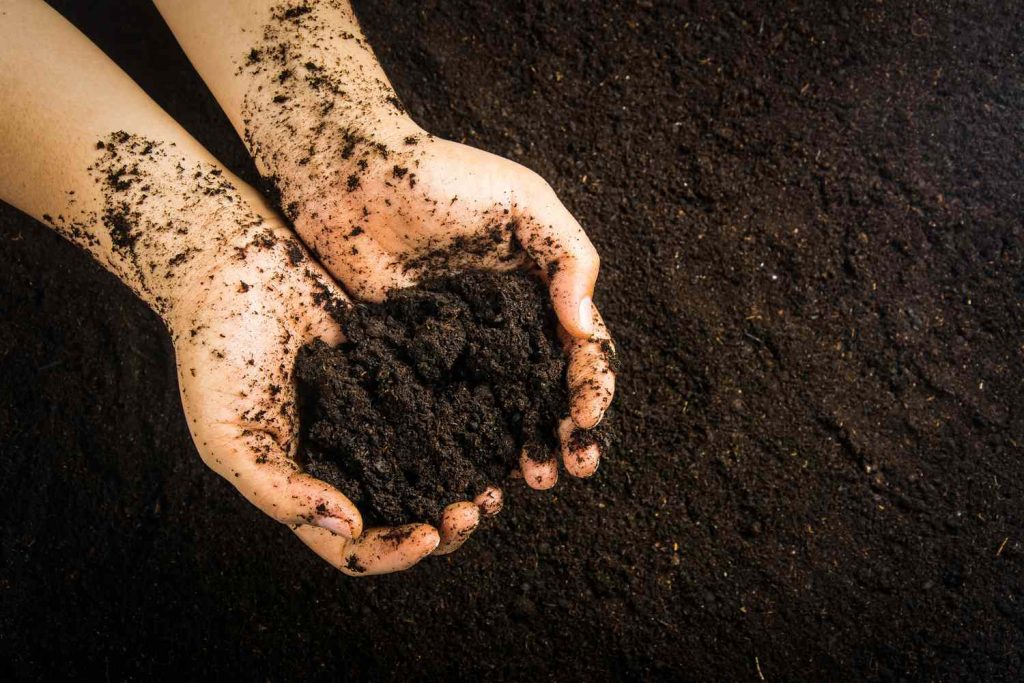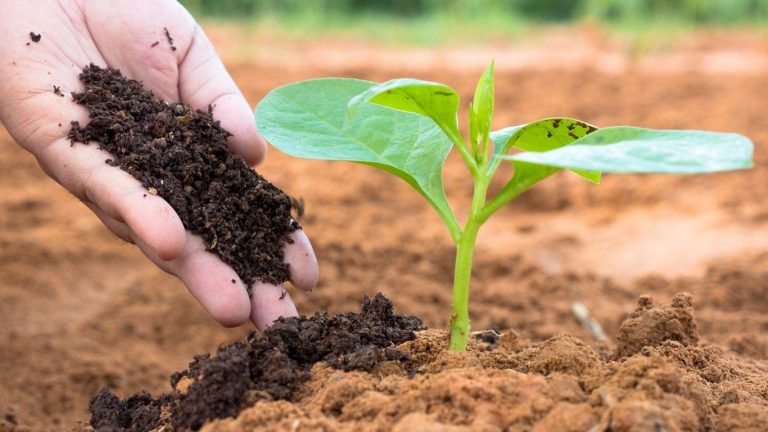HUMUS
The best natural fertilizer for cultivation
100% Organic

Features of humus fertilizer
- Increases the ability to retain and store soil moisture.
- An important source of carbon and nitrogen for plants.
- Improves soil composition and physique for better plant growth
- Contains acids: humic acid & Fluic–acid
This fertilizer is the result of plant rot over 50 years , which has been improved and cleaned with special techniques.

Humus soil
Humus or rotted soils are stable products obtained during the decomposition of carbonaceous materials and are rich in organic matter. Because organic matter has
positive effects on the physical, chemical and biological properties of soil, it is known as a valuable component. The nature of organic waste and its microbial decomposition, which leads to the production of soil organic matter, increase soil quality.
Reasons for needing humus soil
Continuous use of mechanical equipment in this area leads to soil compaction. The resulting density has long–term effects on the physical, chemical and biological properties of the soil, and if proper field management methods are not used, the physical properties of the soil, especially the gradual degradation of soil structure will change. One of
the harmful effects of density is the change in the depth of root development, which in turn affects the amount of water and nutrients absorbed by plants and thus the amount of energy and fertilizer used in agricultural lands, which ultimately leads to the effects.
Features and benefits of our fertilizer
Benefits and effects:
1– Increasing root growth
2– Increasing the absorption of high–consumption nutrients such as phosphorus and nitrogen
3– Inhibition of phosphorus in phosphorus fertilizers
4– Increasing the absorption of macronutrients , especially iron in plants
5– Increasing the speed of plant photosynthesis
6– Increase the nutritional content of the plant
7– Increasing the quantity and quality of agricultural and horticultural products
8– Increasing the germination power of seeds
9– Increasing plant resistance to drought
10– Increasing the activity of microorganisms in the soil
11– Increasing plant resistance to salinity and drought
12– Increasing organic matter and improving the physical condition of the soil
Benefits and effects:
1 – Improves soil structure and increases the absorption of solar energy as the soil darkens.
2– Humic compounds improve soil health by strengthening beneficial microorganisms in the
soil and eliminating harmful microbes.
3– The most important effect of humic acid is to increase the rooting of plants and thus
increase the access to nutrients in the soil.
4– Humic acid makes plants and trees resistant to environmental stresses such as soil salinity
Benefits and effects:
These substances in the soil, in addition to providing part of the plant nutrients and energy of soil organisms (bacteria, earthworms, fungi), improve the physical and chemical conditions of the soil. Such as: improvement of aggregate composition, moisture holding capacity, hydraulic conductivity, volumetric compaction, compaction rate and resistance to water and wind erosion.
Organic acids are an important source of organic matter. One of the most abundant forms of organic matter in nature is humus compounds, which are found in all aquatic and terrestrial environments and play an important role in cation exchange, nutrient release, phosphorus storage capacity, and the preservation of metallic and toxic organic molecules. Humus directly increases the uptake of macronutrients such as nitrogen, phosphorus, sulfur and micronutrients such as iron, zinc, manganese and copper, and increases the uptake of minerals by mobilizing
and increasing microbiological activity.
Benegits and effects:
Prevents the production of excess carbon dioxide that causes global warming. It is environmentally friendly
Researchers studying anaerobic bacteria in the soil have found that if these bacteria are exposed to the air, their carbon dioxide production will increase.
A recent US federal report attributes climate change to human activities, but there is a more worrying issue than the release of fossil fuels. As we all know, bacteria in the soil produce about one–third of the carbon dioxide that enters the atmosphere each year. But many of these bacteria are ignored.
A new study shows that despite previous assumptions, bacteria that do not need oxygen to produce carbon dioxide are present in most parts of the soil.
The amount of carbon dioxide produced by these bacteria is much lower than normal (aerobic) processes, but if the surrounding soil is exposed to the air or global temperatures rise, this amount increases.
Of course, this model can be implemented in another way. If anaerobic bacteria are exposed to the air, the amount of carbon dioxide entering the atmosphere increases up to 10 times.
Similarly, global warming or changing irrigation patterns along with human efforts to change the climate can accelerate the production of carbon dioxide by soil bacteria. Published in the journal Nature Communications.
Benefits and effects:
It does not contain any pathogenic and harmful fungi. No need for toxic substances or disinfectants.
Benefits and effects:
This product facilitates the growth and movement of plant roots by creating soil porosity and proper air circulation, thus preventing the soil from sticking to each other.
Benefits and effects:
This product increases the plant’s resistance to diseases caused by pests and soil pathogens such as
pathogens, and makes the soil structure stable and rich in valuable nutrients such as essential elements and amino acids. Therefore, it prevents stress in the plant.
Soil, as the main culture medium on which the production and quality of various crops depends, is one of the main factors in reducing the incidence of plant stress. The same is true of plants, because humans need care to protect themselves from disease, and the more valuable nutrients they are provided, the more resistant they are to pathogens. If the soil uses the main nutrients and provides them to the plant, stressors are removed.
Benefits and effects:
This product does not smell serious, light, clean, healthy, odorless, and empty of chemical substances.
Benefits and effects:
This product does not cause the following side effects due to the lack of chemicals and chemical supplements:
1– Chemical residues cause depression, insomnia, muscle contraction and increase unwanted reactions.
2- Excessive accumulation of nitrogen causes a disease in infants called methemoglobinemia, which causes insufϐicient oxygen to reach the body’s tissues.
3- Amines produced from nitrogen in chemical fertilizers lead to cancer.
4– High–level aluminum metal causes asthma, Alzheimer’s, bone disease and its complications at birth.
5- Calcium poisoning leads to neurological complications, growth retardation, cognitive delay, and damage to the kidneys and immune system.
6– High levels of cobalt lead to lung damage.
7– Boron mineral reduces sperm production and reduces irritation of the nose, throat and eyes.
8- Lindane can cause breast cancer, genital cancer and nerve effects.
9– Chlorine–containing substances cause malnutrition of the fetus, pneumonia, muscle paralysis and even death due to loss of respiratory activity.
10– High levels of potassium in chemical fertilizers reduce vitamin C and carotene in plants, such as excessive consumption of nitrogen, increase disease and reduce insect resistance in plants.
Benefits and effects:
This product does not have the following side effects due to the lack of chemical toxins:
1– In chemical toxins: Pesticide residues affect the nervous, respiratory and digestive systems.
2– Malathion in insecticides causes nerve damage if it enters the body.
3– DDT toxins have neurological and carcinogenic effects.
Benefits and effects:
Rotten organic matter in the soil usually has a negative charge and absorbs a large amount of positive soluble salt in the soil like a sponge and has insulating properties that in addition to having a signiϐicant effect on soil water retention, also helps balance soil pH. It also helps to increase soil pores and improve soil granulation, which leads to root growth and increase plant root growth in the soil.
Benefits and effects:
Organic matter in this soil increases soil permeability to climate, increases water holding capacity, lightens soil, reduces ϐlooding and soil degradation, and facilitates soil tillage processes.
Benefits and effects:
This product helps the plants to continue ϐlowering throughout the year and prevents the leaves from turning yellow.
Benefits and effects:
From the slice of moisture, the result is the result of the collection of food elements that can be soaked in water and the game is actively active in the ϐield of seeds and the formation of plants.
Benefits and effects:
For plants to grow well, they must be grown in sterile soil, and if the soil is not sterilized, weeds or pathogens must be removed by disinfecting the soil. However, using pesticides for this purpose may cause the plant to dry out and damage it.

Why is our fertilizer recommended?
Reasons to be superior:
1– product of plant waste decay during 50 years
2– Has a large supply volume (500,000 to 700,000 tons)
3– Produced in the most complete fertilizer conversion factory
4– Humus compost was sterile and cleaned with ultraviolet rays
5– Using a special device to destroy the cell cytoplasm wall causes the organic matter in it to be better available
to the plant and provides the best for the plant.
6– No fungal and bacterial contamination
7– There are no weed seeds in it
8 There are no side effects of chemical fertilizers
9– Licensed: (Environment – Agricultural Organization – Veterinary Organization – Soil and Water Institute –Science and Technology Park) Iran.
10– Very reasonable price and competitive with chemicals
